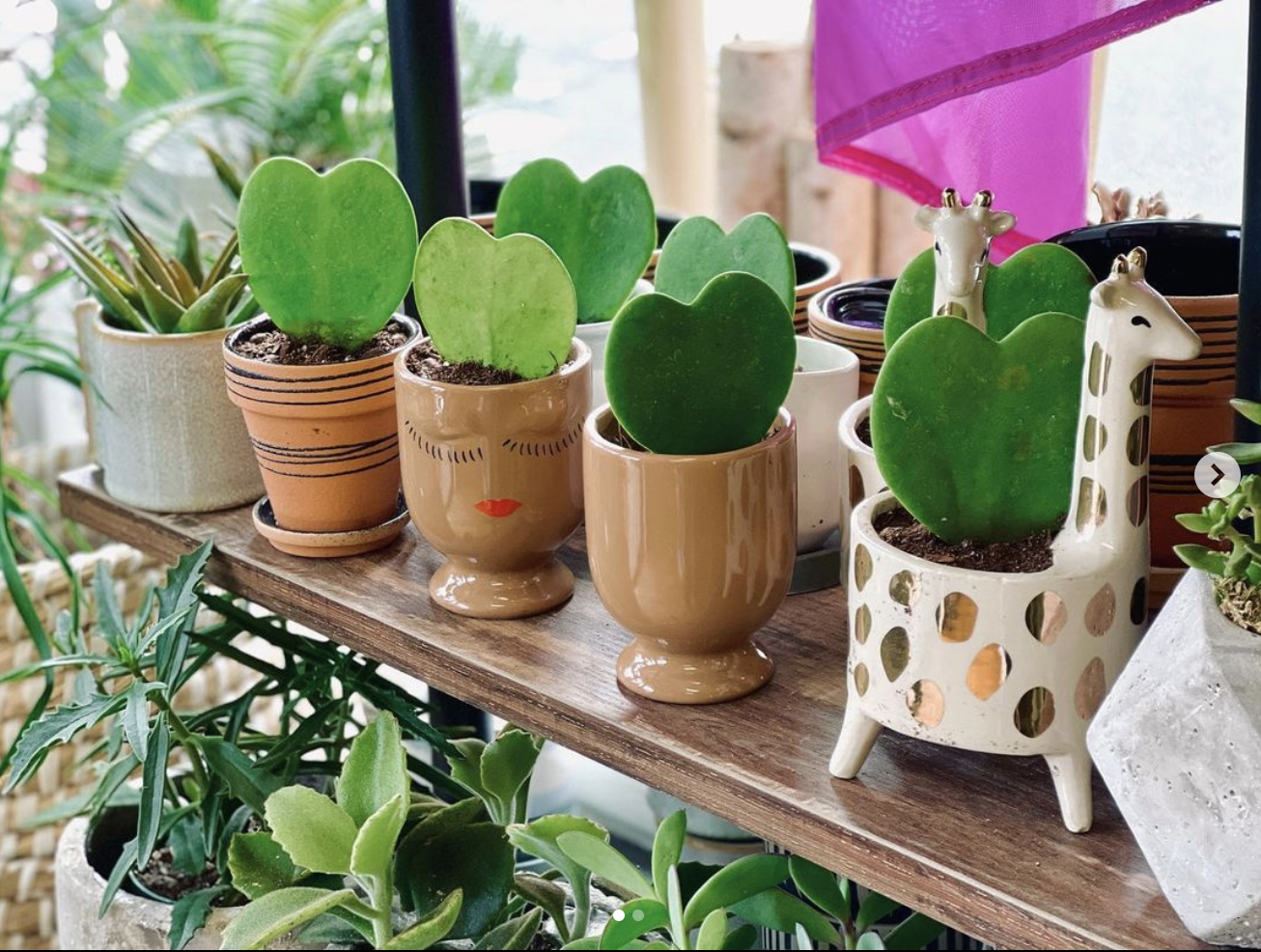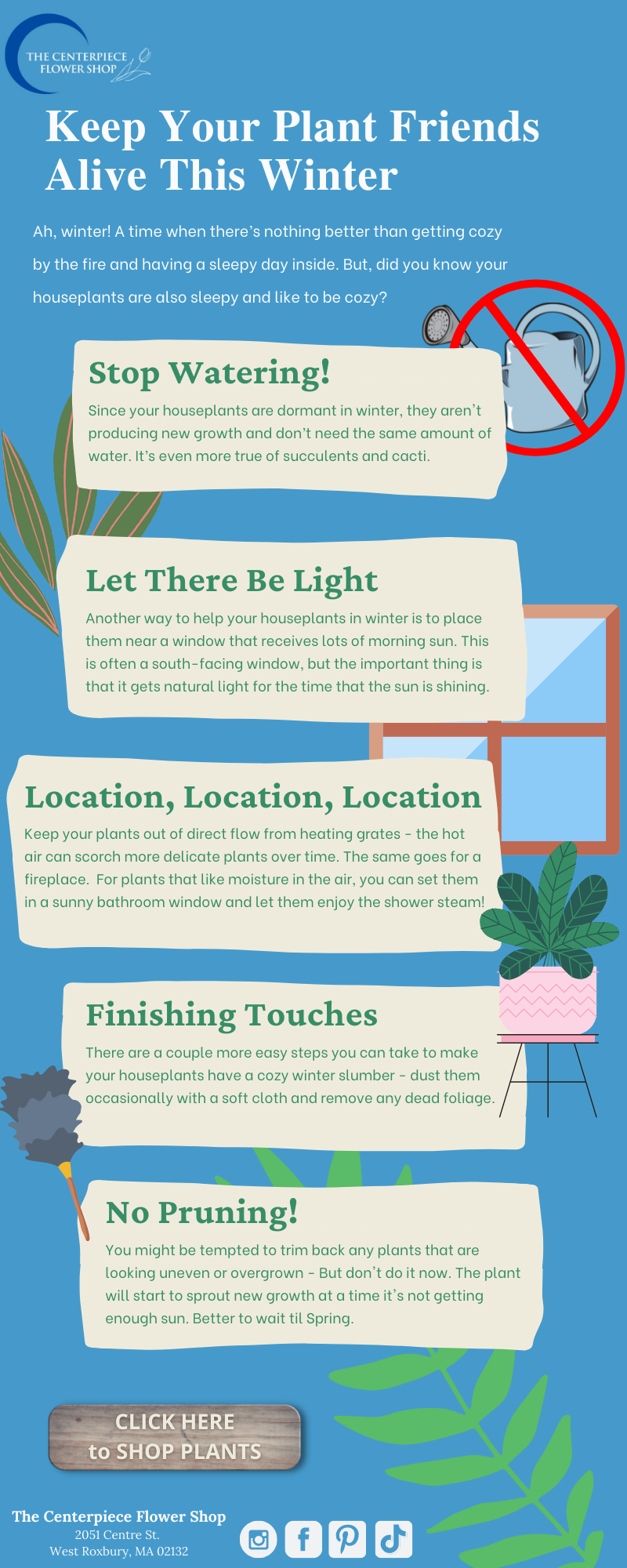Caring for Houseplants in Winter
Keep your houseplants friends alive this winter with tips from The Centerpiece

Caring For Plants In Winter
Ah winter, a time when there’s nothing better than getting cozy by the fire and having a sleepy day inside.
But, did you know your houseplants are also sleepy and like to be cozy?
Winter here is a season of dormancy for plants, including your houseplant friends.
That means that they slow their growth, take in fewer nutrients from the soil, and may even shed some foliage.
All of this is part of the normal seasonal process for them.

CARING FOR HOUSEPLANTS IN WINTER
Ah winter, a time when there’s nothing better than getting cozy by the fire and having a sleepy day inside. But, did you know your houseplants are also sleepy and like to be cozy?
Winter here is a season of dormancy for plants, including your houseplant friends.That means that they slow their growth, take in fewer nutrients from the soil, and may even shed some foliage.
All of this is part of the normal seasonal process for them.
To summarize, keeping your plants alive over their winter dormant period, you just need to take a few simple steps:
1. Stop watering so much
2. Find a sunny window
3. Stay away from drafts, glass, and heating grates
4. Dust occasionally and remove dead foliage
Here at The Centerpiece Flower Shop, our job is a little easier in the winter for one reason: Plants need almost no water in the winter when they are dormant.
The same is true for your houseplants. Since they are so sleepy, they can make use of the water in the same way that they do during their growth periods - spring and summer.
1 IF YOU ONLY DO ONE THING ~ STOP WATERING SO MUCH!
The number one reason that plants don’t survive over winter is that people keep over- watering them. If you keep up the same watering schedule that you used in spring, summer, and fall, then your plants will quickly die. In winter, your plants need very little water.
Since your houseplants are dormant in winter, they are not producing new growth and don’t need the same amount of water. That’s even more true when it comes to succulents and cacti. If you have a cactus or a succulent at home (and we think you should - they are the least maintenance and most interesting plants!), you shouldn’t give them any water all winter.
Overwatering leads to lots of problems for houseplants - As the water builds up in the bottom of the pot, your plant can develop root rot, certain types of fungi, and sometimes even an infestation of gnats or other unwelcome insects. Root rot in particular is often fatal to plants.
But the soil looks so dry! Shouldn’t I just add a little water?
Not really. Remember, just because the top of the soil looks dry doesn’t mean it’s dry all the way to the bottom. Water collects down there, especially if your pot doesn’t have good drainage (a topic for another time). One surefire way to check is to burrow a finger down into the pot and feel the soil at the bottom - Most often it will still be wet, or even soggy. The soil down there should be completely dry before you even think about adding water in winter.
If the soil is completely dry, especially as February turns to March, then it’s a good time to think about adding a little water. Once spring arrives, the winter watering schedule ends.
2 LET THERE BE LIGHT!
One of the main reasons plants go dormant in winter is that there is less sunlight each day. Like many of us, our plants miss the sun and feel less motivated during the gray days of winter. But, just because they are dormant doesn’t mean they need no light.
One way to help your houseplants in winter is to be sure they are close to a window that receives lots of morning sun. This is often a south-facing window, but the important thing is that it gets natural light for the time that the sun is shining.
When you do this, be careful that the window itself is not drafty (most houseplants don’t do well in less than 50oF temperatures), and check to make sure that none of the leaves are pressed against the glass - This could easily lead to freezer burn as the window glass is going to be much colder than the air around it.
If you have an especially fussy plant, you can always make use of a grow light. The technology has greatly improved, and many are both energy efficient and come with timers, sensors, or even remote access to turn them off and on from your smartphone. Of course, adding a grow light is next-level, and not necessary for most kinds of houseplants.
3 LOCATION, LOCATION, LOCATION
Ok, so you stopped adding water and you’ve moved your plants to a bright, sunny window - what else can you do to keep them happy this winter? You can make sure they are in a just-right spot in the house.
First, winter air is very dry and the indoor heat only adds to the dryness. Make sure your plants are out of direct flow from the heating grates - the hot air can scorch more delicate plants over time. The same is even more true about putting a plant too close to a fireplace - even a gas one.
Next, if you do have some plants that like moisture in the air, you can always transfer them to a sunny bathroom window. We’ve had good luck with orchids in the bathroom because they love the humid air of a fresh hot shower nearby.
Be careful, though, as it’s more important that they receive the right amount of light from a window than it is to keep them moist. A quick spritz from a spray bottle can be a good substitute.
4 FINISHING TOUCHES
Okay, so you have your plants situated in an ideal spot - near a sunny window, without touching the glass and away from the heating grates. You’ve cut way back on the water, and stopped watering the cactus and succulents. What next?
There are a couple more easy steps you can take to make your houseplants have a cozy winter slumber - dust them occasionally and remove any dead foliage.
Just as our home heating dries out the air, it also kicks around lots of dust. You may notice that over time your plants’ leaves collect a dull layer of fine particles. This is especially true for broadleaf plants like rubber trees, certain ficus, snake plants, and peace lilies.
All you need to do to make your plants shine in the sunlight is wipe each leaf very carefully with a fuzzy cloth. Be careful not to press or pull too hard on the leaf, but be sure you remove all of the dust from the top of each leaf. This will ensure the plant is able to absorb the maximum amount of sunlight during a time of year when it’s really at a premium.
Lastly, you will want to pinch off any dead leaves or flowers that may be visible - but remember, this is not the time to prune and foster new growth! You just want to remove what the plant has already shed and that you can remove with a minimal effort - geraniums are a great example. If you prune too deeply, the plant will try to sprout new growth at a time when it should be ‘sleeping.’
TO SUMMARIZE...
So to summarize, keeping your plants alive over their winter dormant period, you just need to take a few simple steps:
1. Stop watering so much
2. Find a sunny window
3. Stay away from drafts, glass, and heating grates
4. Dust those leaves occasionally and remove dead foliage
If you ever have questions about your houseplants this winter, we are always here to help! Feel free to drop by the shop for a chat, or send us a message. We love taking care of our customers and helping you develop the greenest of thumbs!
From Ángel, Stephen, and the whole Centerpiece Flower Shop team
Recent Posts
Year : 2025
Year : 2023
Year : 2022
Year : 2021
Year : 2020

